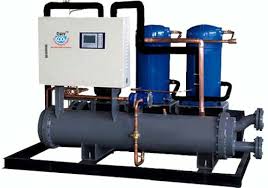A chiller is a refrigeration system that reduces the temperature of machinery, industrial spaces and process fluids. This is does by removing heat from the process and transferring it elsewhere.
In some industries, industrial chillers are essential for temperature control. These include injection moulding, metal plating or food processing.
Chillers are worth using because they provide benefits where strictly defined operating temperatures are required.
When integrated into heat-sensitive processes, chillers prevent thermal damage to the equipment. In addition, they guarantee that there are no changes in the end products that could be damaged by exposure to inappropriate temperatures.
Chiller works as follows: a pump circulates cold water or water/glycol solution from the chiller to the process. The cold fluid removes heat from the process and then heated returns to the chiller. The fluid is transported using coolant hoses.
Chillers contain a chemical compound called a refrigerant. There are many types of refrigerant, but all work on the basic principle of compression and phase transformation from liquid to gas and back to liquid.
This process is called the refrigeration cycle.
The refrigeration cycle starts with a low-pressure mixture of liquid and gas flowing into an evaporator. There, heat from the process water or a solution of water and glycol boils the refrigerant, so that it changes from a low-pressure liquid to a low-pressure gas.
The low-pressure gas enters the compressor, where it is compressed into a high-pressure gas. This then goes into the condenser, which removes heat using ambient air or water. This cools the high-pressure gas into a high-pressure liquid.
Later, the high-pressure liquid moves to the expansion valve, which controls the amount of liquid refrigerant entering the evaporator. From that point on, the refrigeration cycle starts all over again
